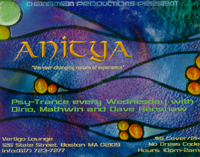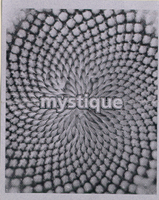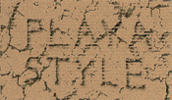In the 1960s, Goa, India became popular among European and American travelers. Having reclaimed independence from the Portuguese Empire in 1961, it appealed to hippy traveling culture as a new site of colonial liberation and became a haven for the international psychedelic community. Throughout the 60s and 70s, Goa maintained popularity. During the dry season, Oct through March, travelers flock to Goa, to celebrate the sun, the beaches, and the freedom. Traveler culture celebrated incorporating new cultures into their own, and an Eastern spiritual influence is evident in the celebration of the Full Moon.
In the 80s Goa Gil, who had moved from San Francisco to Goa in the 70s, began experimenting with sounds in dance music. Influenced by tribal dance, 70s psychedelic rock, 80s new wave/industrial and Detroit techno, Goa Gil created Goa-trance, a synthesis of spiritual traditions of the East and music of the West.
Goa-trance spread as travelers carried the music with them from India. Israeli club culture is dominated by Goa-mostly a result of ėthe post army trip,î the ritual of traveling to India after mandatory military service for Israel. Isreal-trance.com describes Goa as ėjust what the post army traumatic Israeli needed to release all the tensions built into them.î Just as Goa was created by a culture that celebrated freedom of expression, the music induces these feelings.
It’s 10pm, Weds, and half a dozen people have spent the past hour transforming the downstairs bar of Vertigo Lounge from a generic downtown bar into a psychedelic underground, furnishing the space with ultraviolet lights, wall hangings and an electronic beat. Wednesday night is Anitya at Vertigo- the only night of the week there is no dress code at Vertigo and the only Goa weekly in Boston.
The room fills the same way week to week- first with the setup crew from Changmian Productions, a local production company with about 20 members. The resident DJs remain at the booth, one starts spinning, some of the crew starts dancing, and some leave to grab dinner.
The doors are opened, and people walk down the stairs, across the floor, and to the edges of the room to say hello to friends as the beat picks up. Leaning on the bar, Renee tells me she’ll be leaving by midnight tonight. She hands me her new business card and explains that she’ll be working 14 hours a day the next three days. Also a member of Changmian, Renee comes to Anitya every few weeks- to support the night and to spend time with her friends.
12midnite, the Boston Burning Man meet and greet ends, and a dozen people head over to Vertigo. They’ll walk down the stairs and onto the dance floor around just after midnight.
By 12.30am, people have filled the room, and bodies move around the floor- dancing, stomping, spinning- motion that won’t stop until 2am, when the DJ stops mixing and the bouncers turn the red house lights back up. Most of crowd is the same week to week, and you start to recognize people through the black light by patterns in their movement. But before you recognize individual people, the room is a space of synchronous sound and motion.
Anitya remains about the same size week to week, drawing a crowd large enough to fill the room and to sustain the weekly. It’s a strong contrast to other weeklies in town that fill so that dancing is limited to head bobbing. It’s a small crowd- a small community that coalesced around the music of a subculture.
Dino, a resident DJ with Changmian, is excited about the night because it’s an opportunity to expose people to Goa and to bring international DJs to Boston. He talks about finding a venue to host a Goa weekly, and negotiations with Vertigo. A less popular genre of electronic music Goa is less likely to draw as large a crowd or to make as much money for the bar or club than a House or Drum and Bass weekly.
Dino says, “It’s great music, and all people have to do is hear it once and they like it.” But, the music itself keeps the community small. Goa is associated with rave culture- a category popularly known for electronic music, teen culture and drugs. Early raves hosted many genres of music, and as electronic music evolved, different communities formed around different genres. Celebrating Goa-trance means celebrating the subculture of its creation, an element that separates the Goa community from Rave culture.


A club in Springfield hosts all night parties every Friday night. One party in April promotes Jungle all night in the main room, and a 3:30am to close Goa set in the Ambient/Down-tempo/Psychedellic room. Around 3am people from the Boston Goa community arrive in Springfield and sat talking on the couches lining the walls of the small room. Meanwhile, Leonid, a Boston resident, runs visuals – computer generated images of geometric shapes and images from newsreels. The club is 16+, and the main room is filled with teenagers 16 to 20 for most of the night.
Emily explains, “You sort of mature into Goa. I started out listening to hard core, going to raves, and then began listening primarily to Goa.” Vertigo is a 21+ bar, and the Anitya crowd is 20 to 50. Larger New York Goa parties are generally 18+ or 21+, and the crowd is mostly a 24+ international.
Boston clubs close at 2am, so Boston Goa fans travel to all night parties, often leaving Boston Saturday evening to dance in New York from midnight until 7am Sunday. Heather explains that she has stopped traveling for parties because dancing all night Saturday and driving home Sunday morning absorbs too much time. So now, she stays in Boston, goes to Anitya every Wednesday and helps with Changmian, creating most of the wall hangings for their events.
One weekend in April, Mathwin, a resident DJ with Changmian, heard that he could host Absalom, a group from France. They were flying through the East coast on their way to a party in California. Dino says, “It sounded like such a good opportunity, so I told Mathwin I’d help out as much as I could.”
Finding space was difficult- the party was held in the basement of a Boston school dormitory. Space was limited, and 100 invitations were handed out, mostly among the Boston Goa community. Because Boston parties are held in small private spaces, invitations are limited, creating an air of exclusivity that seems to counter the belief that everyone should share in listening and dancing to the music.
“It’s like any other subculture,” says Alpha, comparing Goa culture to Dead Head culture. “When I was following the Dead, it was the same. You got together with a group of people who you know just because you share an interest in the same music, and most of your activities are based around that.”
In late April, the Boston Burning man group ran a party in late April with several local Goa DJs. The party was open, held in the Somerville VFW, and a large part of the crowd overlapped with the Anitya crowd. The party began with a drum circle as people set up for the party- Mathwin, Jeff Mission and Schwilly B spun, and Leonid ran visuals.



